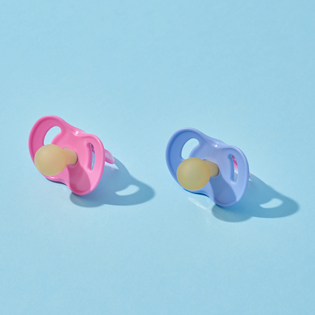If anyone ever deserved a break, it’s a nursing mom, so your desire to have your little one take a bottle so that you can go for a much-needed walk (or at least take a shower or a nap) is completely understandable, and in fact essential to your well-being.
But are you worried that your little one won’t take to the bottle easily? Heard one too many “nipple confusion” sagas from friends and lactation specialists? Or has that theory been discounted by the pediatrician and your mother-in-law, leaving you more confused than ever? Here’s the straight scoop.
What is nipple confusion?
Nipple confusion is a term used to describe babies who are used to sucking from bottles and have a hard time getting back on the breast. They may may protest the different size or texture of a mom’s nipple.
Is nipple confusion real?
A baby who seems more accepting of bottle-feeding than breastfeeding isn’t confused. She’s simply showing her inclination for drinking from the bottle.
Here’s why that can happen: Newborns catch on pretty quickly that they don’t have to work nearly as hard to get milk from bottles with rubber (or silicone) nipples as from the breast.
To breastfeed, your baby needs to master the fine art of taking your nipple far back into her mouth and then using her tongue to pump out the milk (which can take a minute or so before it starts flowing). With a tilted bottle, a baby has gravity on her side: She can suck with her lips and get all the milk she wants right away.
So the baby suffering from nipple confusion may not be befuddled so much as opinionated. She prefers the bottle. And why wouldn’t she? It’s the quicker, easier route to a full belly.
Read This Next
Bottle preference is far from guaranteed though. In fact, most babies have no problem switching from breast to bottle and back again — and some do so with ease from the get-go.
But others, particularly those who take a little longer perfecting the art of suckling at the breast, do find it hard to transition from breast to bottle and then back to breast. Which is why most experts agree that you should wait until your newborn gets the hang of breastfeeding before you break out the bottle.
When to introduce the bottle
For breastfed babies, three weeks is the sweet spot for bringing out the bottle. That allows for enough time for your milk supply to get well established and for your newborn to really master the technique.
On the other hand, it’s still early enough in your newborn’s nursing journey that she doesn’t end up rejecting the bottle because it feels too unfamiliar.
If you haven't hit your groove with breastfeeding by the three-week mark, ask your pediatrician if you should wait a little longer before introducing the bottle.
How to help your baby switch from breast to bottle
To encourage your little sipper to switch more seamlessly from breast to bottle, stick with these strategies.
Introduce the bottle at the right time.
Wait to offer the bottle to your breastfed baby until about three weeks after birth. That’s enough time for you to establish your milk supply and for her to hone her nursing technique, but not so long that she ends up getting too used to the breast.
Use the right nipple.
What’s “right” ultimately depends on your baby’s preferences, so be willing to experiment with a few different options. That said, you might find the most success with a slow-flow nipple (sometimes called a newborn nipple).
These tend to slow the pace of feeding, so it’s a little more like nursing. How can you tell if milk is flowing from the bottle at a good speed? The milk is likely coming out too fast if your baby is making gulping or sputtering sounds. And if she’s becoming excessively frustrated or seems like she’s straining, it’s probably coming out too slow.
Don’t make it effortless.
Remember, your baby has to work a little harder to get milk from your breast compared to from a bottle. You can slow the flow by holding the bottle at a tilt instead of vertically. Take frequent breaks to stretch out the length of the meal overall too.
Will using a pacifier lead to a bottle preference?
Despite what you might hear from well-meaning family or friends, offering your baby a pacifier won’t make her like bottle-feeding more or lose interest in breastfeeding.
Not only can pacifiers soothe your baby while giving you a much-needed break, but offering them at nap and bedtime in particular may reduce the risk for sudden infant death syndrome (SIDS), according to the American Academy of Pediatrics (AAP).
The key is introducing the pacifier after you’ve both gotten the hang of breastfeeding. Just like with bottles, you’ll want to wait to pop the pacifier until your baby is 3 or 4 weeks old, the AAP recommends.
How to fix bottle preference
If your newborn seems to go gaga for the bottle and not much else, don’t worry. With a little time and effort you can undo that preference and steer her back towards the breast.
- Go back to square one. Revisit the basics of latching on and remind your baby how soothing breastfeeding can be by cuddling her skin-to-skin. It may require a few sessions of fumbling at the breast before she gets back on track, but it’ll be worth it!
- Make it easier. Get your milk flowing (either manually or by pumping your breast milk) before your baby starts to eat, so she doesn’t have to work that hard for the milk. Just pump enough to get things dripping; you’re not looking to fill a bottle just yet.
- Time it right. She should be in the mood for a meal (aka hungry) so she’s motivated to give it a try ... but not so famished that she can’t get her baby brain around relearning an old trick. If she’s starving, she may not have the patience to latch on or suck hard enough to get the milk she wants — and that might lead to a full-blown frenzy of frustration, which can throw both of you off track.
- Back off on the bottles. If the whole switcheroo has given your baby a bad case of nipple confusion, just stick with breastfeeding till she’s got it down solid.
Newborns who’ve taken to the bottle but are still struggling with nursing often have trouble latching on properly. That might look like:
- Becoming overly fussy or frustrated when she tries to nurse
- Her face starting to turn red
- Making clicking noises while trying to nurse
- Chewing or rooting while trying to nurse
- Nipple pain for you
What to do if your baby prefers breastfeeding
Sometimes introducing the bottle to a breastfed baby (particularly if you wait more than three or four weeks after birth) can bring on the opposite problem: A baby who won’t take the bottle at all.
That can be frustrating — especially when you could use a break or are getting ready to go back to work — but, again, is a speed bump you can overcome. Some tips:
Let someone else do the honors.
Sometimes a baby is just too attached to Mom’s nipple, so hitting the bottle while Mom is so close by (yet buttoned-up) seems wrong. But it may be a different story if someone else is bringing on the bottle — whether a partner, grandparent or best pal.
But don’t worry that you’ll always need a Mommy stand-in at feeding time — once your wee one gets the hang of the bottle, she won’t care who gives it to her!
Try different nipple types.
If one bottle nipple doesn’t succeed, try, try another one. Just watch the flow rate. The milk should come out fast enough that your baby doesn’t get frustrated … but not so fast that she can’t keep up with the flow. A drop a second when you turn the bottle upside-down is just right.
Make bottle-feeding as much like breastfeeding as you can.
Interact with your baby. Switch arms halfway through so she has something different to look at. Burp her. But remember that while some newborns want bottle-feeding to be just like breastfeeding, others take to it better if the experience is completely different. So if that’s the case with yours, try a different location or even a different position.
How to balance breastfeeding and bottle-feeding
Bottle- or breastfeeding doesn't have to be an all-or-nothing choice. By spacing out feedings, finding a formula that baby likes almost as much as mom's breast milk and including lots of skin-on-skin bonding, you'll be able to enjoy the flexibility of both.












































 Trending On What to Expect
Trending On What to Expect





